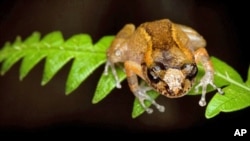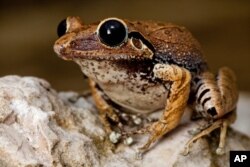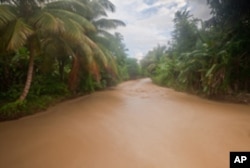As Haiti marks the first anniversary of the devastating earthquake that destroyed its capital, the Haitian people continue to struggle to rise from the ruins that still surround them.
One sign of hope is in the country’s dwindling forested region, where a team of scientists journeyed late last year in search of lost frogs.
Frog hunt
Robin Moore led the frog hunt. He’s a scientist with Conservation International and leader of a global campaign to find lost frogs. He spent eight days last October in the cloud forest in the southern part of the country, scouring trees, river beds and ground cover for frogs.
One day, he heard a call from a frog that was easy to identify but hard to catch. “One of the challenges is it really does throw its voice," Moore says. "So we would spend an hour, an hour and a half, honing in on this frog and we kept finding that we weren’t finding it where it was supposedly calling from.”
It turned out to be a strategy the Hispaniolan Ventriloquial frog uses to defend itself against predators. The tiny brown and orange frog hadn’t been seen in 20 years. The team also found five other lost species and about half of the 50 amphibians known to live in the region.
Moore says this was an encouraging sign given such widespread deforestation in Haiti, where only two percent of the original forest survives. “We’re at a point where we need to try to really protect these last fragments of forest in order to have something to build on.”
Looking to the future
Moore says the surviving healthy forest underscores the importance of protecting natural ecosystems for the services they provide, not only for amphibians, but for the entire watershed.
“They are filtering water that is supplying downstream communities and cities downstream including Port-au-Prince that is supplied by water that originates in these mountains.”
Moore says if forests are cleared, the soil erodes and muddies the water people use to drink. “So, just one of the services provided by the forests is clean water.”
Conservation International plans to work with non-governmental groups in Haiti to help people learn how to make a living from the forest without destroying it. Moore says the cultivation of shade grown coffee is one such idea.
“It’s hard for them to invest in things like this because it is a long-term investment. So we want to be able to absorb some of that risk and provide ways for them to earn a living without having to cut down the forest, to make charcoal, to clear areas to grow cash crops.”
Moore says, managed properly, species and ecosystems can become a source of natural wealth and national pride for Haiti.














